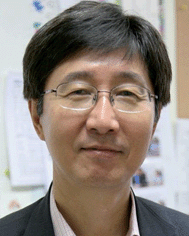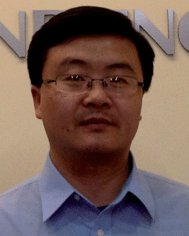Themed issue on perovskite solar cells
Zhiqun
Lin
a,
Nam-Gyu
Park
b and
Gang
Li
c
aSchool of Materials Science and Engineering, Georgia Institute of Technology, 771 Ferst Dr., Molecular Science & Engineering Bldg., Atlanta, GA 30332-0245, USA. E-mail: zhiqun.lin@mse.gatech.edu; Fax: +1-404-385-3734; Tel: +1-404-385-4404
bSchool of Chemical Engineering, Sungkyunkwan University (SKKU), Suwon 440-746, Korea. E-mail: npark@skku.edu; Tel: +82-31-290-7241
cDepartment of Materials Science and Engineering, University of California, Los Angeles, 405 Hilgard Avenue, Los Angeles, CA 90095, USA. E-mail: gangl@ucla.edu
 Zhiqun Lin |
 Nam-Gyu Park |
 Gang Li |
One promising route to relieving world-wide energy and environmental threats is the exploitation of solar energy by developing high-efficiency, low-cost, and eco-friendly solar cells. Since the first practical manufacturing of silicon solar cells, they have led commercial solar-cell markets with the highest power conversion efficiency (PCE) of nearly 28%. Recent advances in the chemical dye synthesis, device engineering, and photoelectric mechanism study have greatly promoted the development of polymer solar cells, dye-sensitized solar cells (DSSCs), and organic–inorganic hybrid solar cells. They have been widely recognized as viable candidates for third-generation solar cells, and are chasing after the high efficiency and excellent stability of silicon solar cells.
The breakthrough discovery of organometal halide perovskites as superior materials to convert solar energy into electrical energy has completely changed the photovoltaic competition. Initially, the discovery of high-temperature superconductivity in perovskite materials sparked research interest in this class of materials. In 2009, a pioneering work on the photovoltaic application of organolead halide perovskites as visible-light sensitizers in DSSCs triggered the swift development of perovskite solar cells. Subsequently, the replacement of the iodide/triiodide liquid electrolyte with a solid-state hole transport layer profoundly increased the PCE of perovskite-sensitized DSSCs up to nearly 10% in 2012. Research on organolead halide perovskite solar cells has actually been accelerated since the report on solid-state perovskite solar cells. In the past five years, the photovoltaic performance of organolead halide perovskite solar cells has recently surpassed 20%. A series of strategies have been successfully developed to improve the efficiency, including device interfacial engineering, chemical compositional tuning, and crystallization kinetics control. Attempts to reduce the bandgap, enhance light absorption, and eventually improve the photovoltaic efficiency of perovskite oxides are also garnering much attention, due to the potential intriguing combination of photovoltaic, ferroelectric, and piezoelectric effects in these low-bandgap perovskite oxide materials. More efforts are being devoted to exploring the fundamental photophysical mechanisms of perovskite-based solar cells, especially the relationship between the chemical components and the optoelectronic behaviors. Achievement of 28% efficiency by combining the perovskite solar cell with the silicon solar cell reported in 2015 shows that a tandem solar cell structure with perovskite and other types of solar cells (e.g. Si, CIGS) has the potential to go beyond the 30% efficiency mark. In addition, the hybridization of organometal halide perovskite solar cells with other semiconducting devices (e.g., photocatalytic water splitting, lithium battery, supercapacitor, etc.) has largely extended the applications of perovskite solar cells, and provided a potentially promising new platform for economic, large-scale, and high-efficiency integrated energy devices.
These days, more and more exciting new results are published in the related areas. Journal of Materials Chemistry A is an interdisciplinary journal, publishing work of international significance on all aspects of materials chemistry related to energy and sustainability, including (but not limited to): materials for energy storage and conversion, materials for sustainability, and materials for living. This themed issue aims to cover the most recent progress in the synthesis, preparation, characterization, and mechanism study of perovskite-based solar cells, to reflect the extraordinarily rapid development in the synthesis, engineering, and application of perovskites.
| This journal is © The Royal Society of Chemistry 2015 |
